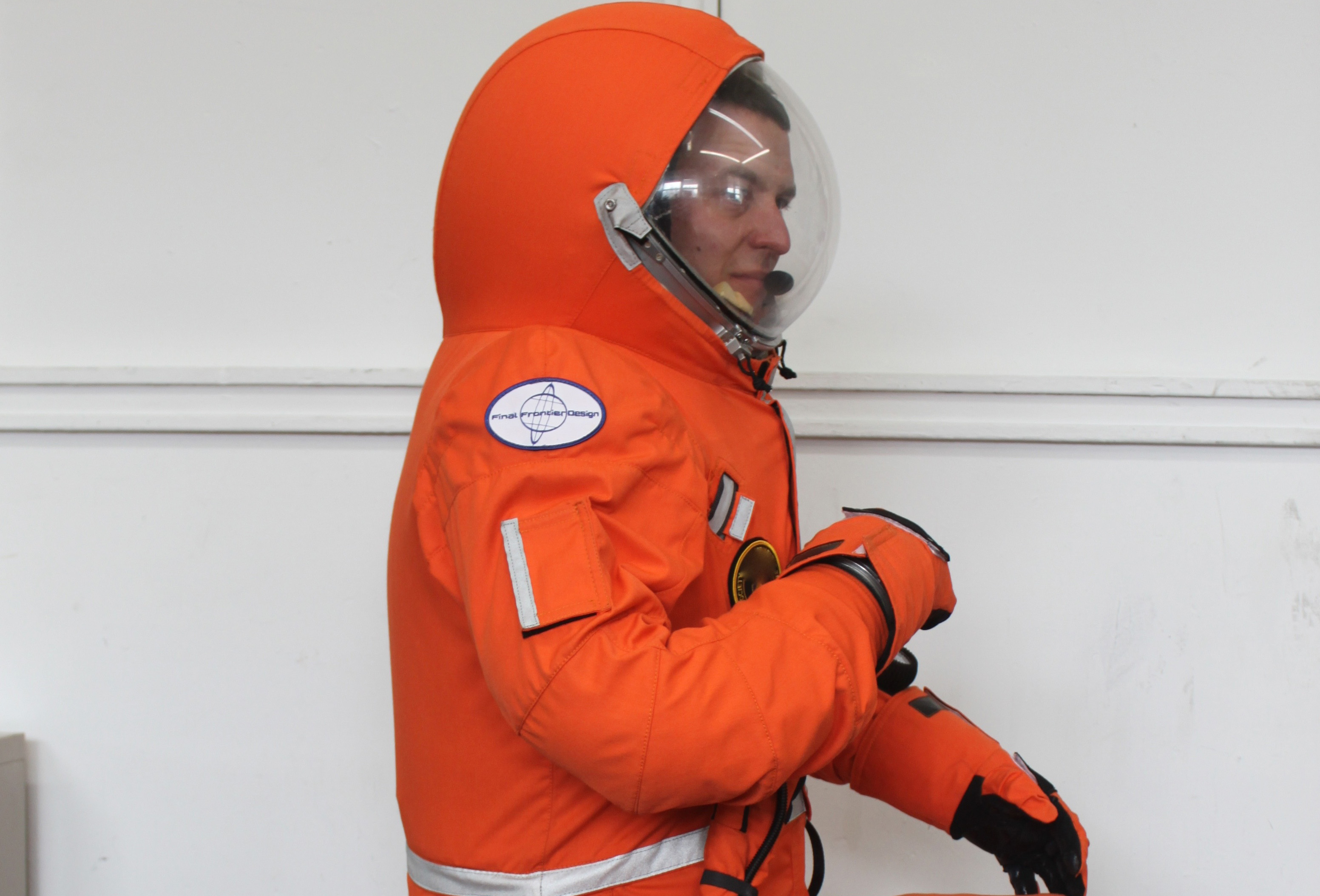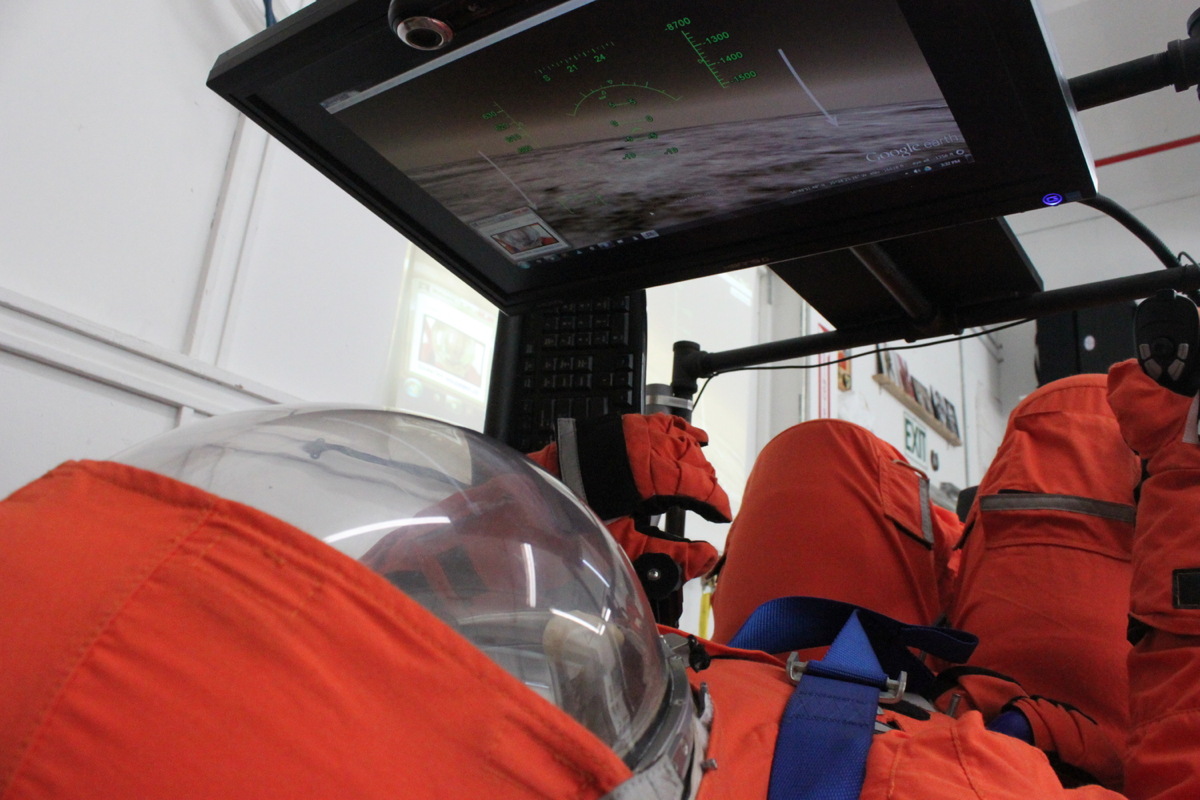What to Wear in Space: Spacesuit Chic with Final Frontier Design

It all started with a glove.
In 2009, two previously competing designers teamed up to build a spacesuit glove to enter in a NASA competition. After taking home second prize and winning $100,000 for their high-tech creation, Ted Southern and Nikolay Moiseev decided to go into business together.
Today, the partners at Final Frontier Design are on the third version of their spacesuit after building the first in 2010. They have slowly made improvements to their design, and one day, the team hopes to sell its suits to commercial companies hoping to launch private astronauts into space. [See photos of the Final Frontier Design spacesuit]
Southern and Moiseev are a bit of an odd couple. Moiseev started off in the detail-oriented world of engineering in the Russian space program, while Southern got his undergraduate degree in classical music performance before moving on to fine arts. But it seems to work for them and their New York-based company.
Space.com sat down with the Final Frontier Design partners to talk about spacesuits, engineering and the odd middle-ground between science and art.
Space.com: Why build spacesuits?
Ted Southern: I had sort of a catch phrase when I was younger about wanting to extend the ability of the human body. There are a lot of different ways that people do that — with firefighter turnout gear, with racecar driver gear and even with underwater gear — submersibles, things like that, it's almost an extension of the body. But for me, working through art and costuming many years ago, spacesuits really cried out to me as the perfect manifestation of my interests.
Breaking space news, the latest updates on rocket launches, skywatching events and more!
For a while, I made body armor, historical body armor, and I see spacesuits as the modern analogue of Henry VIII-style armor. Very similar complexity and mobility issues they're dealing with. A lot of times it, was governments that contracted both spacesuits and body armor.
In the bigger picture, and in terms of Final Frontier Design as a business, spacesuits are a mandatory part of human spaceflight. There needs to be some redundancy in every system for any crewed vehicle, and pressure redundancy is usually found through a spacesuit itself. The analogue for commercial airline travel would be the oxygen masks that fall from above in case of a loss of cabin pressure. If you're up at 100,000 feet [3,048 meters] or even higher, at ISS [International Space Station] levels, low-Earth orbit, a mask doesn't really do you any good anymore. You need to cover your whole body to protect [yourself] from pressure.
Space.com: Where did you start off, and how did Final Frontier Design come to be?
T.S.: When I moved to New York, I joked with people that I wanted to make body armor for a living. In fact, I found a place fairly quickly — a costume shop in Chelsea — that actually does make body armor. I worked there for five or six years before going back to graduate school, but learned a lot about materials and processes, and actually a fair amount of technique and technical processes for costumes that are more than just period pieces, that actually help people perform in extreme situations like for Cirque du Soleil or Broadway shows.
I went back to graduate school and got my masters in fine arts and sculpture, but everything I made in graduate school had to do with hands and hand functionality in particular. Hands are really what make us human and allow us to interact with the world, and toward the end of my graduate stint, NASA has a citizen inventor challenge called the "astronaut glove challenge," which seemed like the perfect outlet for my thesis. So I coincided my thesis gallery show with this technical project, the astronaut glove challenge. [Evolution of NASA Spacesuits in Pictures]
Space.com: You're up to the third generation of your suit now. What is the newest suit like?
T.S.: We've built three 3G [third-generation] suits at this point. We're on our third iteration of the third generation. They're all fairly similar, but there are some particular patterning improvements on each design, and we've also advanced the manufacturing process where all the pieces are laser-cut. Before, we were cutting by hand. And we have some hardware advancements in the newer 3G suits.
Space.com: Who do you hope will buy the spacesuits?
T.S.: In terms of a customer to really buy the suits, we're looking at launch providers and training companies. There's a whole host of them that are interested, and we're currently working on a couple.
Space.com: Nikolay, you have some pretty extensive experience with spacesuit design. Where did you start before you partnered with Ted?
Nikolay Moiseev: I'm from Moscow, Russia. I spent almost 21 years in Russian space program, and left my position as lead designer and project manager for advanced spacesuits. My first gloves worked in open space since 1988, so hundreds and hundreds of EVAs [extra-vehicular activity, or spacewalks]. I'm proud that nobody lost nails in my gloves.
Space.com: Why are gloves important?
N.M.: Spacesuit is [firstly] clothes for astronauts. The second, it is pressure garment. Astronauts have difficulty bending in any joint, so without special design, joint or spacesuit, you couldn't move elbow or a lot of joints in the glove. For example, NASA's glove does have the four knuckle joints, only the finger joints.
Space.com: What is it like to combine science and art in your everyday work? What does it mean to be in the middle of the two?
T.S.: People are often surprised that I used to and actually still make costumes. [They think] it's so different: costumes and spacesuits. In fact, I see the continuum exactly the same. There's a lot more at stake with a spacesuit than there is for a wing for Victoria's Secret, for instance, but the thought process and the concept is a very similar thing. You want the person to be comfortable. You want the object itself to work well, and it needs to be reliable. [See images of a NASA spacesuit designed for Mars]
Even with Victoria's Secret, we only had one shot down the runway, so whatever its was we sent down the runway had to work. With Broadway shows, Broadway show costumes are incredibly complex, and they have to work eight times a week. They perform eight times a week. If something fails on that, it's my butt that's got to go up to Broadway, to Times Square and fix. Some of those Cirque du Soleil costumes, people's lives really are on the line, so they have to be comfortable and adequate for the dancers. I really do see it as a continuum. There is more time and money involved with spacesuits than there is with costumes, just by necessity, and there is more complexity, but it's a continuum, and it's definitely a space that we occupy in between.
Space.com: What is it like for you and Nik to work together?
T.S.: I think that it's surprising sometimes, and I don't think Nik totally disagrees with me when I say this: On paper, Nik is the scientist and I'm the artist, so I have weird ideas and he follows protocol. But in reality, sometimes it switches where Nik has a crazy idea, and I say, "No, no we have to slow down, follow protocol, what's the science? How are the standards working?" It's not a cut and dry relationship in that way. We're both creative and scientific.
Space.com: Would you go to space if given the chance?
T.S.: Yes. Before I started with the astronaut glove competition, I didn't really obsess about space at all, but the more I learned about it, the more I got interested and the more there was to know, and it's just sort of been a down-the-rabbit-hole thing. I would absolutely go to space. It's a once-in-a-lifetime opportunity, and it's one of these things that's the ultimate experience. Discomfort aside, I wouldn't miss [out on] it at all.
Space.com: If someone handed you a ticket to go to the space station, would you?
N.M.: Definitely not. I'm going to Mars.
This Q&A has been edited for length and clarity.
Follow Miriam Kramer @mirikramer and Google+. Follow us @Spacedotcom, Facebook and Google+. Original article on Space.com.

Miriam Kramer joined Space.com as a Staff Writer in December 2012. Since then, she has floated in weightlessness on a zero-gravity flight, felt the pull of 4-Gs in a trainer aircraft and watched rockets soar into space from Florida and Virginia. She also served as Space.com's lead space entertainment reporter, and enjoys all aspects of space news, astronomy and commercial spaceflight. Miriam has also presented space stories during live interviews with Fox News and other TV and radio outlets. She originally hails from Knoxville, Tennessee where she and her family would take trips to dark spots on the outskirts of town to watch meteor showers every year. She loves to travel and one day hopes to see the northern lights in person. Miriam is currently a space reporter with Axios, writing the Axios Space newsletter. You can follow Miriam on Twitter.



